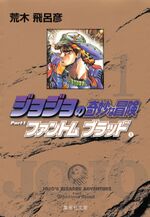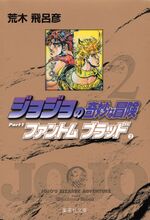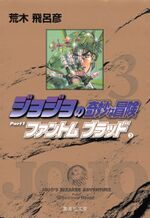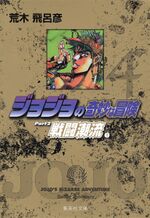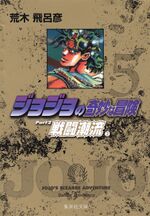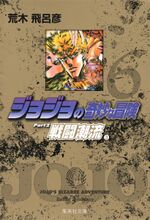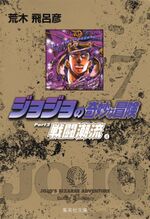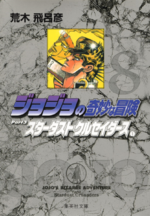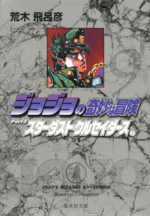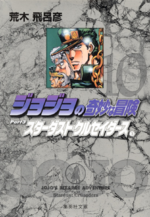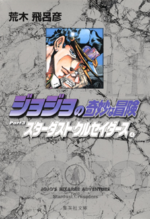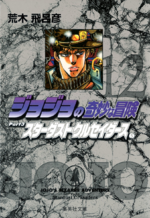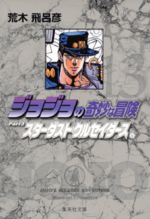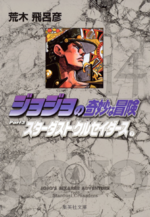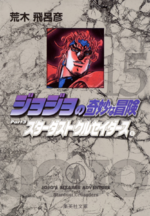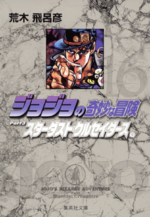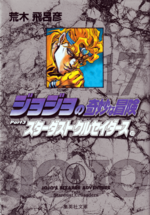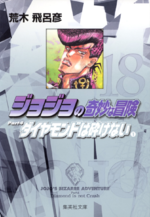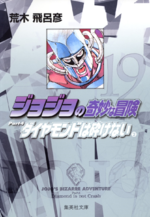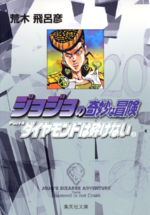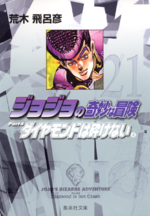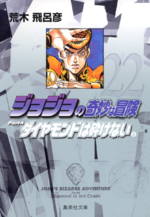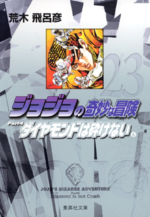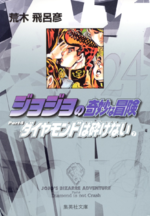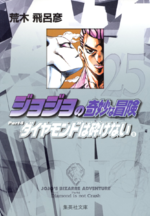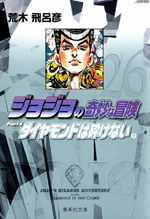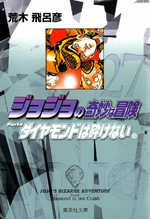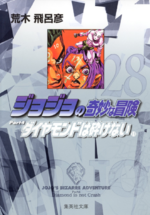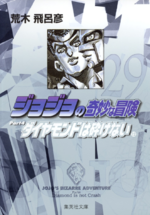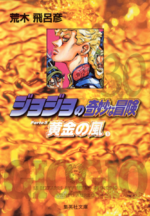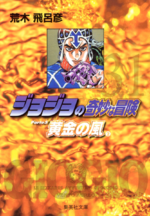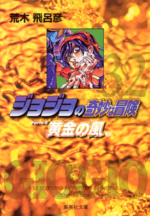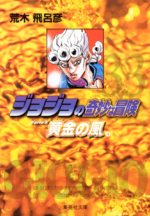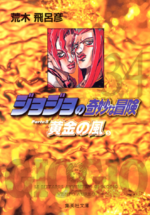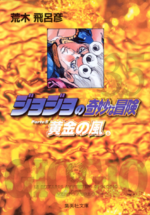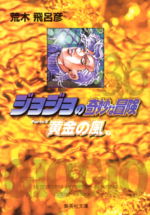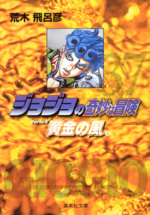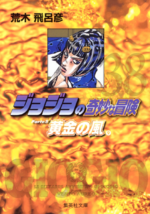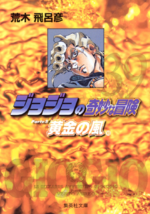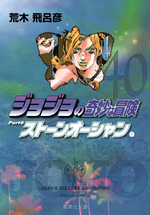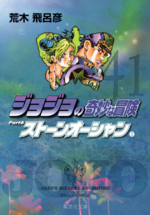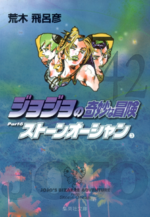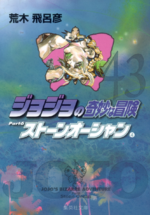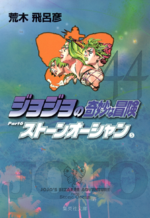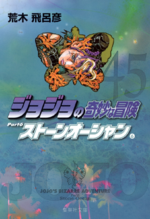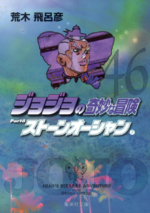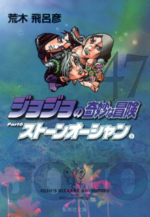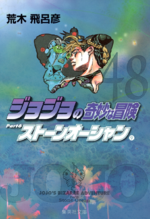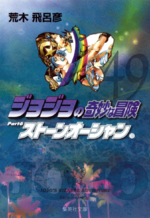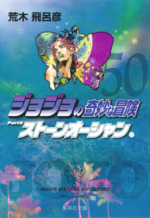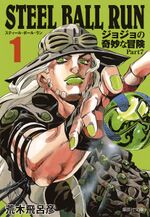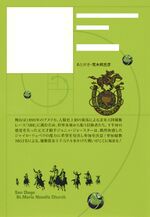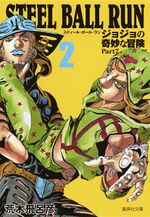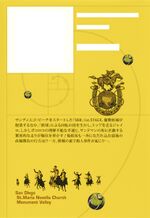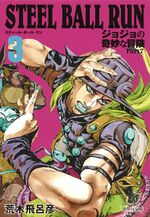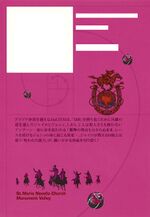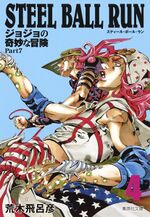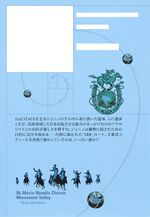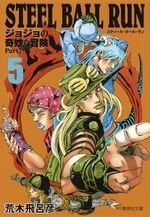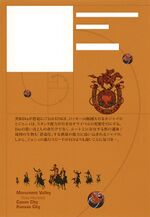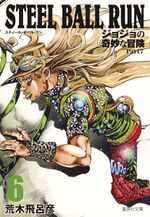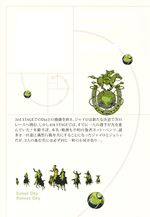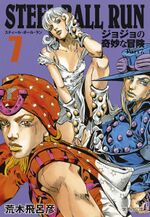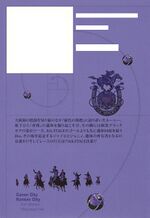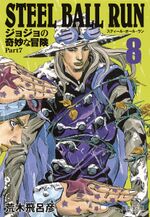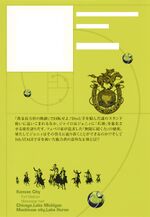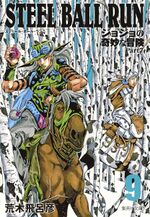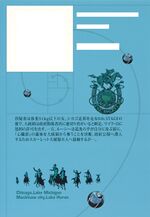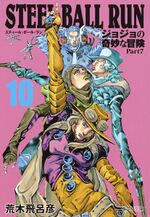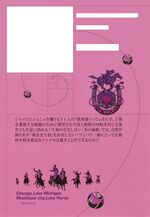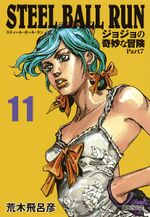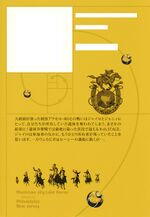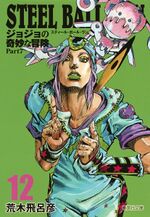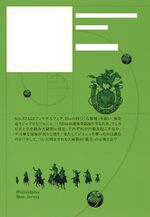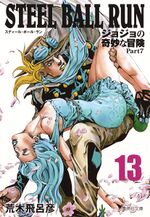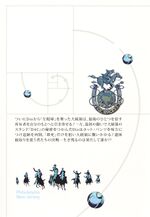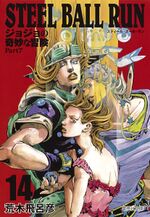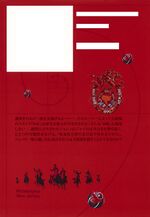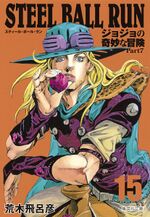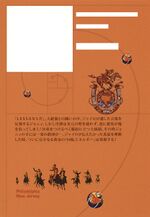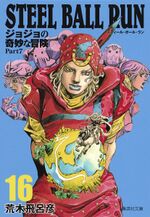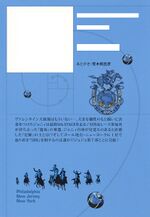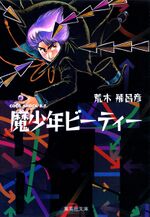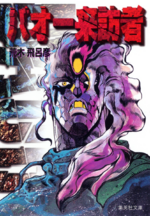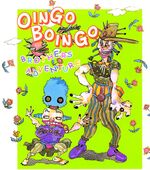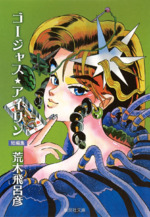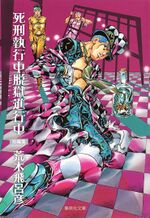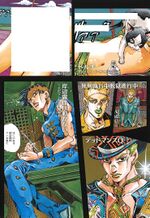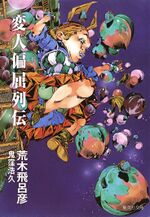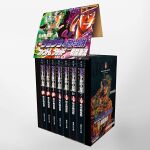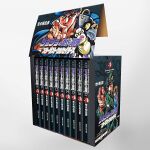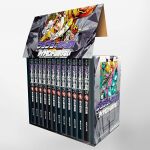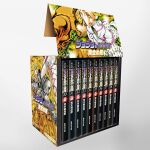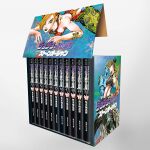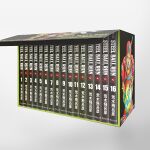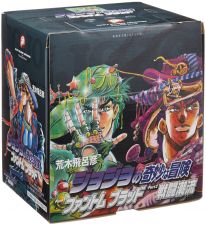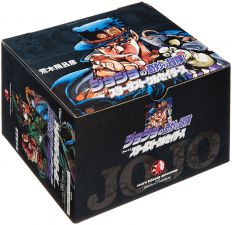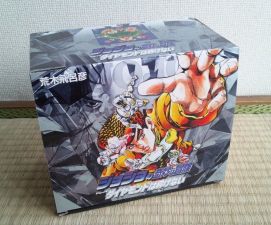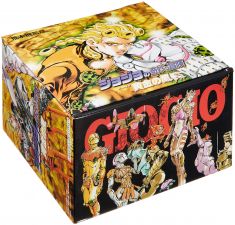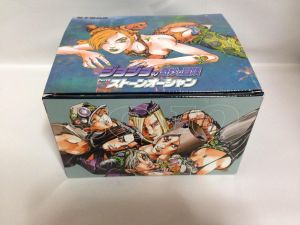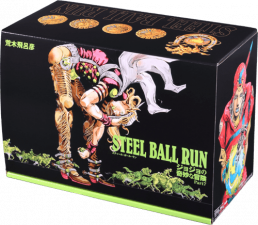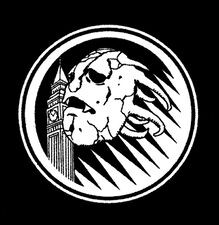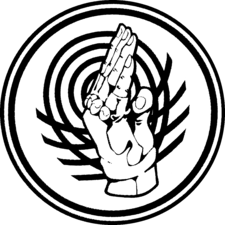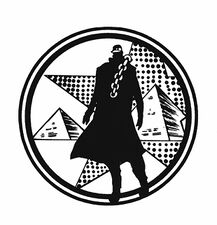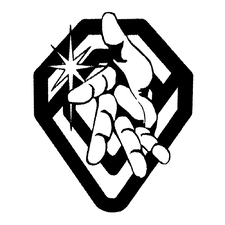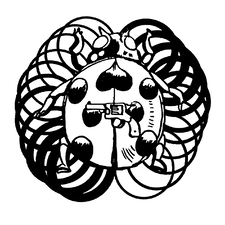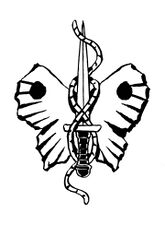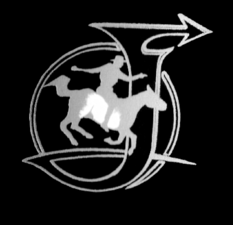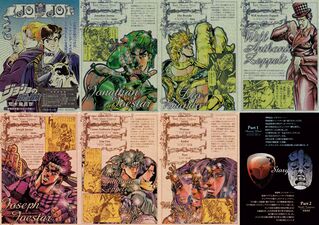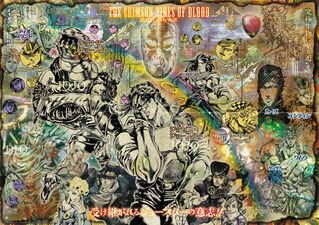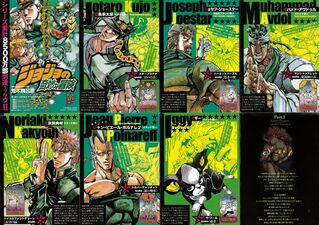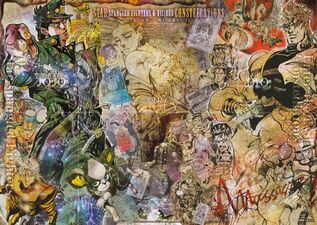JoJo's Bizarre Adventure (Shueisha Paperback Edition)
The Shueisha Paperback Edition (集英社文庫(コミック版), Shūeisha Bunko (Komikku-ban)) is a paperback or bunkoban release (105 mm (4.1 in) by 148 mm (5.8 in), A6 size) of the first seven parts of the JoJo's Bizarre Adventure manga, in addition to various other works by Hirohiko Araki. Though physically smaller than the standard tankōbon editions, each paperback volume of the main series contains more pages and chapters than a standard tankōbon volume.
Summary
The release of the paperback edition of JoJo's Bizarre Adventure began with the release of Phantom Blood, now compiled into three volumes, on February 15, 2002. The next five Parts were gradually released over the next seven years, with the series reaching 50 volumes in total. The final volume of Stone Ocean was released on February 18, 2009. The first two volumes of Steel Ball Run's paperback edition were released on February 17, 2017, dropping most of the prior Parts' branding. The remaining 14 volumes of the Part were again released over time, with the final two volumes both being released on January 18, 2018.
Other works by Hirohiko Araki, namely Gorgeous Irene, Under Execution, Under Jailbreak, The Lives of Eccentrics, would receive paperback editions from September 2011 through October 2012; Cool Shock B.T. and Baoh the Visitor had already received paperback editions on June 16, 2000, and Oingo Boingo Brothers Adventure had been exclusively released in paperback format on October 18, 2002.
On August 31, 2012, all 12 paperback volumes of Diamond is Unbreakable were made available digitally as the monochrome line of JOJO-D. the digitally-released edition of the JoJo's Bizarre Adventure manga. Distributed under Shueisha's Jump Comics DIGITAL (ジャンプコミックスDIGITAL) product line, the JOJO-D release allows readers to digitally purchase or read volumes through online outlets. Volumes could also be downloaded to mobile devices through Shueisha's own Jump Store app for iOS and Android prior to its discontinuation. Vento Aureo and Stone Ocean were made available in the following weeks, and Parts 1-3 were made available on September 21, 2012. Unlike Parts 1-6, JOJO-D digitally published the tankōbon release of Steel Ball Run rather than the paperback release, a decision that extended to JoJolion and The JOJOLands.
Volumes
Phantom Blood Volume 1
- Prologue (プロローグ, Purorōgu)
- Dio Brando the Invader, Part 1 (侵略者ディオ・ブランドー その①, Shinryakusha Dio Burandō Sono 1)
- Dio Brando the Invader, Part 2 (侵略者ディオ・ブランドー その②, Shinryakusha Dio Burandō Sono 2)
- Dio Brando the Invader, Part 3 (侵略者ディオ・ブランドー その③, Shinryakusha Dio Burandō Sono 3)
- Dio Brando the Invader, Part 4 (侵略者ディオ・ブランドー その④, Shinryakusha Dio Burandō Sono 4)
- A Letter from the Past, Part 1 (過去からの手紙 その①, Kako kara no Tegami Sono 1)
- A Letter from the Past, Part 2 (過去からの手紙 その②, Kako kara no Tegami Sono 2)
- The Stone Mask, Part 1 (石仮面 その①, Ishi Kamen Sono 1)
- The Stone Mask, Part 2 (石仮面 その②, Ishi Kamen Sono 2)
- The Stone Mask, Part 3 (石仮面 その③, Ishi Kamen Sono 3)
- The Stone Mask, Part 4 (石仮面 その④, Ishi Kamen Sono 4)
- Youth with Dio, Part 1 (ディオとの青春 その①, Dio to no Seishun Sono 1)
- Youth with Dio, Part 2 (ディオとの青春 その②, Dio to no Seishun Sono 2)
- Youth with Dio, Part 3 (ディオとの青春 その③, Dio to no Seishun Sono 3)
Phantom Blood Volume 2
- Youth with Dio, Part 4 (ディオとの青春 その④, Dio to no Seishun Sono 4)
- Youth with Dio, Part 5 (ディオとの青春 その⑤, Dio to no Seishun Sono 5)
- The Birth of DIO (
DIO の誕生, DIO no Tanjō) - Jack the Ripper and Zeppeli the Strange, Part 1 (切り裂きジャックと奇人ツェペリ その①, Kirisaki Jakku to Kijin Tseperi Sono 1)
- Jack the Ripper and Zeppeli the Strange, Part 2 (切り裂きジャックと奇人ツェペリ その②, Kirisaki Jakku to Kijin Tseperi Sono 2)
- Jack the Ripper and Zeppeli the Strange, Part 3 (切り裂きジャックと奇人ツェペリ その③, Kirisaki Jakku to Kijin Tseperi Sono 3)
- Jack the Ripper and Zeppeli the Strange, Part 4 (切り裂きジャックと奇人ツェペリ その④, Kirisaki Jakku to Kijin Tseperi Sono 4)
- Jack the Ripper and Zeppeli the Strange, Part 5 (切り裂きジャックと奇人ツェペリ その⑤, Kirisaki Jakku to Kijin Tseperi Sono 5)
- Ripple Overdrive, Part 1 (
波紋疾走 その①, Hamon Ōbādoraibu Sono 1) - Ripple Overdrive, Part 2 (
波紋疾走 その②, Hamon Ōbādoraibu Sono 2) - Ripple Overdrive, Part 3 (
波紋疾走 その③, Hamon Ōbādoraibu Sono 3) - Tarkus and the Dark Knight Bruford, Part 1 (タルカスと黒騎士ブラフォード その①, Tarukasu to Kuro Kishi Burafōdo Sono 1)
- Tarkus and the Dark Knight Bruford, Part 2 (タルカスと黒騎士ブラフォード その②, Tarukasu to Kuro Kishi Burafōdo Sono 2)
- Tarkus and the Dark Knight Bruford, Part 3 (タルカスと黒騎士ブラフォード その③, Tarukasu to Kuro Kishi Burafōdo Sono 3)
- Tarkus and the Dark Knight Bruford, Part 4 (タルカスと黒騎士ブラフォード その④, Tarukasu to Kuro Kishi Burafōdo Sono 4)
Phantom Blood Volume 3
- Sleep as a Hero (英雄として瞑る, Eiyū toshite Nemuru)
- The Knights' Ruins (騎士たちの遺跡, Kishitachi no Iseki)
- The Medieval Knights' Training Ground for Murder (中世騎士殺人修練場, Chūsei Kishi Satsujin Shūren Jō)
- Pluck for Tomorrow and the Successor, Part 1 (あしたの勇気・うけ継ぐ者 その①, Ashita no Yūki Uketsugumono Sono 1)
- Pluck for Tomorrow and the Successor, Part 2 (あしたの勇気・うけ継ぐ者 その②, Ashita no Yūki Uketsugumono Sono 2)
- Pluck for Tomorrow and the Successor, Part 3 (あしたの勇気・うけ継ぐ者 その③, Ashita no Yūki Uketsugumono Sono 3)
- The Three from a Faraway Land, Part 1 (遥かな国からの3人 その①, Haruka na Kuni kara no 3-nin Sono 1)
- The Three from a Faraway Land, Part 2 (遥かな国からの3人 その②, Haruka na Kuni kara no 3-nin Sono 2)
- The Three from a Faraway Land, Part 3 (遥かな国からの3人 その③, Haruka na Kuni kara no 3-nin Sono 3)
- Fire and Ice, Jonathan and Dio, Part 1 (
炎 と氷 ジョナサンとディオ その①, Faiyā to Aisu Jonasan to Dio Sono 1) - Fire and Ice, Jonathan and Dio, Part 2 (
炎 と氷 ジョナサンとディオ その②, Faiyā to Aisu Jonasan to Dio Sono 2) - Fire and Ice, Jonathan and Dio, Part 3 (
炎 と氷 ジョナサンとディオ その③, Faiyā to Aisu Jonasan to Dio Sono 3) - Fire and Ice, Jonathan and Dio, Part 4 (
炎 と氷 ジョナサンとディオ その④, Faiyā to Aisu Jonasan to Dio Sono 4) - Fire and Ice, Jonathan and Dio, Part 5 (
炎 と氷 ジョナサンとディオ その⑤, Faiyā to Aisu Jonasan to Dio Sono 5) - Fire and Ice, Jonathan and Dio, Part 6 (
炎 と氷 ジョナサンとディオ その⑥, Faiyā to Aisu Jonasan to Dio Sono 6)
Battle Tendency Volume 1
- Joseph Joestar of New York, Part 1 (ニューヨークのジョセフ・ジョースター その①, Nyū Yōku no Josefu Jōsutā Sono 1)
- Joseph Joestar of New York, Part 2 (ニューヨークのジョセフ・ジョースター その②, Nyū Yōku no Josefu Jōsutā Sono 2)
- Joseph Joestar of New York, Part 3 (ニューヨークのジョセフ・ジョースター その③, Nyū Yōku no Josefu Jōsutā Sono 3)
- Straizo vs. Joseph, Part 1 (ストレイツォ
VS ジョセフ その①, Sutoreitso tai Josefu Sono 1) - Straizo vs. Joseph, Part 2 (ストレイツォ
VS ジョセフ その②, Sutoreitso tai Josefu Sono 2) - Straizo vs. Joseph, Part 3 (ストレイツォ
VS ジョセフ その③, Sutoreitso tai Josefu Sono 3) - Straizo vs. Joseph, Part 4 (ストレイツォ
VS ジョセフ その④, Sutoreitso tai Josefu Sono 4) - Straizo vs. Joseph, Part 5 (ストレイツォ
VS ジョセフ その⑤, Sutoreitso tai Josefu Sono 5) - The Pillar Man (「柱の男」, 'Hashira no Otoko')
- The Pillar Man, Santana, Part 1 (「柱の男・サンタナ」 その①, 'Hashira no Otoko Santana' Sono 1)
- The Pillar Man, Santana, Part 2 (「柱の男・サンタナ」 その②, 'Hashira no Otoko Santana' Sono 2)
- The Pillar Man, Santana, Part 3 (「柱の男・サンタナ」 その③, 'Hashira no Otoko Santana' Sono 3)
- The Pillar Man, Santana, Part 4 (「柱の男・サンタナ」 その④, 'Hashira no Otoko Santana' Sono 4)
- The Pillar Man, Santana, Part 5 (「柱の男・サンタナ」 その⑤, 'Hashira no Otoko Santana' Sono 5)
- The Pillar Man, Santana, Part 6 (「柱の男・サンタナ」 その⑥, 'Hashira no Otoko Santana' Sono 6)
- The Pillar Man, Santana, Part 7 (「柱の男・サンタナ」 その⑦, 'Hashira no Otoko Santana' Sono 7)
- The Pillar Man, Santana, Part 8 (「柱の男・サンタナ」 その⑧, 'Hashira no Otoko Santana' Sono 8)
- The Pillar Man, Santana, Part 9 (「柱の男・サンタナ」 その⑨, 'Hashira no Otoko Santana' Sono 9)
Battle Tendency Volume 2
- Joseph Joestar of Rome (ローマのジョセフ・ジョースター, Rōma no Josefu Jōsutā)
- The Red Stone of Aja (エイジャの赤石, Eija no Sekiseki)
- Ultimate Warriors from Ancient Times, Part 1 (太古から来た究極戦士 その①, Taiko kara Kita Kyūkyoku Senshi Sono 1)
- Ultimate Warriors from Ancient Times, Part 2 (太古から来た究極戦士 その②, Taiko kara Kita Kyūkyoku Senshi Sono 2)
- Ultimate Warriors from Ancient Times, Part 3 (太古から来た究極戦士 その③, Taiko kara Kita Kyūkyoku Senshi Sono 3)
- Ultimate Warriors from Ancient Times, Part 4 (太古から来た究極戦士 その④, Taiko kara Kita Kyūkyoku Senshi Sono 4)
- Ultimate Warriors from Ancient Times, Part 5 (太古から来た究極戦士 その⑤, Taiko kara Kita Kyūkyoku Senshi Sono 5)
- An Engagement with Death: The Wedding Ring (死の契約・
結婚指輪 , Shi no Keiyaku Wedingu Ringu) - Ripple Teacher Lisa Lisa, Part 1 (波紋教師 リサリサ その①, Hamon Kyōshi Risa Risa Sono 1)
- Ripple Teacher Lisa Lisa, Part 2 (波紋教師 リサリサ その②, Hamon Kyōshi Risa Risa Sono 2)
- Ripple Teacher Lisa Lisa, Part 3 (波紋教師 リサリサ その③, Hamon Kyōshi Risa Risa Sono 3)
- Ripple Teacher Lisa Lisa, Part 4 (波紋教師 リサリサ その④, Hamon Kyōshi Risa Risa Sono 4)
- Ripple Teacher Lisa Lisa, Part 5 (波紋教師 リサリサ その⑤, Hamon Kyōshi Risa Risa Sono 5)
- Ripple Teacher Lisa Lisa, Part 6 (波紋教師 リサリサ その⑥, Hamon Kyōshi Risa Risa Sono 6)
- Go! Ripple Master (行け!波紋マスター, Ike! Hamon Masutā)
- Flame Mode Esidisi, Part 1 (炎・
流法 エシディシ その①, Honō Mōdo Eshidishi Sono 1) - Flame Mode Esidisi, Part 2 (炎・
流法 エシディシ その②, Honō Mōdo Eshidishi Sono 2)
Battle Tendency Volume 3
- Flame Mode Esidisi, Part 3 (炎・
流法 エシディシ その③, Honō Mōdo Eshidishi Sono 3) - The Remains Lurk, Part 1 (忍びよる残骸 その①, Shinobi Yoru Zangai Sono 1)
- The Remains Lurk, Part 2 (忍びよる残骸 その②, Shinobi Yoru Zangai Sono 2)
- Stroheim's Unit Strikes Back, Part 1 (シュトロハイム隊の逆襲 その①, Shutōrohaimu-tai no Gyakushū Sono 1)
- Stroheim's Unit Strikes Back, Part 2 (シュトロハイム隊の逆襲 その②, Shutōrohaimu-tai no Gyakushū Sono 2)
- Stroheim's Unit Strikes Back, Part 3 (シュトロハイム隊の逆襲 その③, Shutōrohaimu-tai no Gyakushū Sono 3)
- Light Mode Kars, Part 1 (光・
流法 カーズ その①, Hikari Mōdo Kāzu Sono 1) - Light Mode Kars, Part 2 (光・
流法 カーズ その②, Hikari Mōdo Kāzu Sono 1) - Caesar: A Lonely Youth, Part 1 (シーザー孤独の青春 その①, Shīzā Kodoku no Seishun Sono 1)
- Caesar: A Lonely Youth, Part 2 (シーザー孤独の青春 その②, Shīzā Kodoku no Seishun Sono 2)
- Caesar: A Lonely Youth, Part 3 (シーザー孤独の青春 その③, Shīzā Kodoku no Seishun Sono 3)
- Caesar: A Lonely Youth, Part 4 (シーザー孤独の青春 その④, Shīzā Kodoku no Seishun Sono 4)
- Caesar: A Lonely Youth, Part 5 (シーザー孤独の青春 その⑤, Shīzā Kodoku no Seishun Sono 5)
- Caesar: A Lonely Youth, Part 6 (シーザー孤独の青春 その⑥, Shīzā Kodoku no Seishun Sono 6)
- Climb Out of the Fortified Hotel (要塞ホテルを登り切れ, Yōsai Hoteru o Noborikire)
- The Wind, the Chariot, and Wamuu, Part 1 (風と戦車とワムウ その①, Kaze to Sensha to Wamū Sono 1)
- The Wind, the Chariot, and Wamuu, Part 2 (風と戦車とワムウ その②, Kaze to Sensha to Wamū Sono 2)
Battle Tendency Volume 4
-
Maximum number of allowed loops reached
Stardust Crusaders Volume 1
-
Maximum number of allowed loops reached
Stardust Crusaders Volume 2
-
Maximum number of allowed loops reached
Stardust Crusaders Volume 3
-
Maximum number of allowed loops reached
Stardust Crusaders Volume 4
-
Maximum number of allowed loops reached
Stardust Crusaders Volume 5
-
Maximum number of allowed loops reached
Stardust Crusaders Volume 6
-
Maximum number of allowed loops reached
Stardust Crusaders Volume 7
-
Maximum number of allowed loops reached
Stardust Crusaders Volume 8
-
Maximum number of allowed loops reached
Stardust Crusaders Volume 9
-
Maximum number of allowed loops reached
Stardust Crusaders Volume 10
-
Maximum number of allowed loops reached
Diamond is Unbreakable Volume 1
-
Maximum number of allowed loops reached
Diamond is Unbreakable Volume 2
-
Maximum number of allowed loops reached
Diamond is Unbreakable Volume 3
-
Maximum number of allowed loops reached
Diamond is Unbreakable Volume 4
-
Maximum number of allowed loops reached
Diamond is Unbreakable Volume 5
-
Maximum number of allowed loops reached
Diamond is Unbreakable Volume 6
-
Maximum number of allowed loops reached
Diamond is Unbreakable Volume 7
-
Maximum number of allowed loops reached
Diamond is Unbreakable Volume 8
-
Maximum number of allowed loops reached
Diamond is Unbreakable Volume 9
-
Maximum number of allowed loops reached
Diamond is Unbreakable Volume 10
-
Maximum number of allowed loops reached
Diamond is Unbreakable Volume 11
-
Maximum number of allowed loops reached
Diamond is Unbreakable Volume 12
-
Maximum number of allowed loops reached
Vento Aureo Volume 1
-
Maximum number of allowed loops reached
Vento Aureo Volume 2
-
Maximum number of allowed loops reached
Vento Aureo Volume 3
-
Maximum number of allowed loops reached
Vento Aureo Volume 4
-
Maximum number of allowed loops reached
Vento Aureo Volume 5
-
Maximum number of allowed loops reached
Vento Aureo Volume 6
-
Maximum number of allowed loops reached
Vento Aureo Volume 7
-
Maximum number of allowed loops reached
Vento Aureo Volume 8
-
Maximum number of allowed loops reached
Vento Aureo Volume 9
-
Maximum number of allowed loops reached
Vento Aureo Volume 10
-
Maximum number of allowed loops reached
Stone Ocean Volume 1
-
Maximum number of allowed loops reached
Stone Ocean Volume 2
-
Maximum number of allowed loops reached
Stone Ocean Volume 3
-
Maximum number of allowed loops reached
Stone Ocean Volume 4
-
Maximum number of allowed loops reached
Stone Ocean Volume 5
-
Maximum number of allowed loops reached
Stone Ocean Volume 6
-
Maximum number of allowed loops reached
Stone Ocean Volume 7
-
Maximum number of allowed loops reached
Stone Ocean Volume 8
-
Maximum number of allowed loops reached
Stone Ocean Volume 9
-
Maximum number of allowed loops reached
Stone Ocean Volume 10
-
Maximum number of allowed loops reached
Stone Ocean Volume 11
-
Maximum number of allowed loops reached
Steel Ball Run Volume 1
Steel Ball Run Volume 2
-
Maximum number of allowed loops reached
- Extra Chapter
- ~How the Steel Ball Run Race Got Started~ (~スティール・ボール・ランレース開催のいきさつ~, ~Stīu Bōru Ran Rēsu Kaisai no Ikisatsu~)
Steel Ball Run Volume 3
Steel Ball Run Volume 4
Steel Ball Run Volume 5
-
Maximum number of allowed loops reached
- Extra Chapter
- The Story of F. Valentine (ザ ストーリー オブ ファニー・ヴァレンタイン, Za Sutōrī obu Fani Varentain)
Steel Ball Run Volume 6
Steel Ball Run Volume 7
-
Maximum number of allowed loops reached
- Extra Chapter
Steel Ball Run Volume 8
Steel Ball Run Volume 9
Steel Ball Run Volume 10
Steel Ball Run Volume 11
Steel Ball Run Volume 12
Steel Ball Run Volume 13
Steel Ball Run Volume 14
Steel Ball Run Volume 15
Steel Ball Run Volume 16
-
Maximum number of allowed loops reached
-
Maximum number of allowed loops reached
Oingo Boingo Brothers Adventure
オインゴとボインゴ兄弟大冒険 Oingo to Boingo Kyōdai Daibōken
The future-predicting manga Oingo Boingo Brothers Adventure carried around by Boingo, user of the Stand representing the god of writing, Tohth, has been released as a paperback. Read all of the hilarious episodes of the brothers Oingo and Boingo, who fought with all their might to defeat Jotaro Kujo and company.
Gorgeous Irene
ゴージャス★アイリン Gōjasu Airin
Under Execution, Under Jailbreak
死刑執行中脱獄進行中 Shikei Shikkōchū Datsugoku Shinkōchū
Box Sets
Box Set 1 - Phantom Blood & Battle Tendency
Part 1:
- 1. ISBN: 978-4086177849
- 2. ISBN: 978-4086177856
- 3. ISBN: 978-4086177863
Part 2:
- 4. ISBN: 978-4086177870
- 5. ISBN: 978-4086177887
- 6. ISBN: 978-4086177894
- 7. ISBN: 978-4086177900
Box Set 2 - Stardust Crusaders
Box Set 3 - Diamond is Unbreakable
Box Set 4 - Vento Aureo
Box Set 5 - Stone Ocean
Box Set 6 - Steel Ball Run
Afterwords
Gallery
Trivia
- The box sets for the first three parts have the same number of volumes as the JoJonium releases.
- This edition introduces some mild censoring, removing certain phrases that would now be considered homophobic, sexist, or demeaning to the intellectually-disabled. All subsequent editions, including the JoJonium and digital releases, retain these changes.
- This version has been fully published in Italian by Star Comics, and serves as the basis for the Spanish, Argentinean, Mexican, Brazilian, German, Polish, and Indonesian editions of the series.
- In August 2013, the 44th printing of Volume 9 (Stardust Crusaders) and 43rd printing of Volume 25 (Diamond is Unbreakable) were misprinted with pages swapped between them. For example, in Volume 9, after Hol Horse tells Polnareff that the man with two right hands is nearby, the next page showed Rohan Kishibe. The volumes were later recalled from stores.[81]
References
- ↑ ジョジョの奇妙な冒険/1/Part1 ファントムブラッド 1
- ↑ ジョジョの奇妙な冒険/1/Part1 ファントムブラッド 2
- ↑ ジョジョの奇妙な冒険/1/Part1 ファントムブラッド 3
- ↑ ジョジョの奇妙な冒険/4/Part2 戦闘潮流 1
- ↑ ジョジョの奇妙な冒険/5/Part2 戦闘潮流 2
- ↑ ジョジョの奇妙な冒険/6/Part2 戦闘潮流 3
- ↑ ジョジョの奇妙な冒険/7/Part2 戦闘潮流 4
- ↑ ジョジョの奇妙な冒険/8/Part3 スターダストクルセイダース 1
- ↑ ジョジョの奇妙な冒険/9/Part3 スターダストクルセイダース 2
- ↑ ジョジョの奇妙な冒険/10/Part3 スターダストクルセイダース 3
- ↑ ジョジョの奇妙な冒険/11/Part3 スターダストクルセイダース 4
- ↑ ジョジョの奇妙な冒険/12/Part3 スターダストクルセイダース 5
- ↑ ジョジョの奇妙な冒険/13/Part3 スターダストクルセイダース 6
- ↑ ジョジョの奇妙な冒険/14/Part3 スターダストクルセイダース 7
- ↑ ジョジョの奇妙な冒険/15/Part3 スターダストクルセイダース 8
- ↑ ジョジョの奇妙な冒険/16/Part3 スターダストクルセイダース 9
- ↑ ジョジョの奇妙な冒険/17/Part3 スターダストクルセイダース 10
- ↑ ジョジョの奇妙な冒険/18/Part4 ダイヤモンドは砕けない 1
- ↑ ジョジョの奇妙な冒険/19/Part4 ダイヤモンドは砕けない 2
- ↑ ジョジョの奇妙な冒険/20/Part4 ダイヤモンドは砕けない 3
- ↑ ジョジョの奇妙な冒険/21/Part4 ダイヤモンドは砕けない 4
- ↑ ジョジョの奇妙な冒険/22/Part4 ダイヤモンドは砕けない 5
- ↑ ジョジョの奇妙な冒険/23/Part4 ダイヤモンドは砕けない 6
- ↑ ジョジョの奇妙な冒険/24/Part4 ダイヤモンドは砕けない 7
- ↑ ジョジョの奇妙な冒険/25/Part4 ダイヤモンドは砕けない 8
- ↑ ジョジョの奇妙な冒険/26/Part4 ダイヤモンドは砕けない 9
- ↑ ジョジョの奇妙な冒険/27/Part4 ダイヤモンドは砕けない 10
- ↑ ジョジョの奇妙な冒険/28/Part4 ダイヤモンドは砕けない 11
- ↑ ジョジョの奇妙な冒険/29/Part4 ダイヤモンドは砕けない 12
- ↑ ジョジョの奇妙な冒険/30/Part5 黄金の風 1
- ↑ ジョジョの奇妙な冒険/31/Part5 黄金の風 2
- ↑ ジョジョの奇妙な冒険/32/Part5 黄金の風 3
- ↑ ジョジョの奇妙な冒険/33/Part5 黄金の風 4
- ↑ ジョジョの奇妙な冒険/34/Part5 黄金の風 5
- ↑ ジョジョの奇妙な冒険/35/Part5 黄金の風 6
- ↑ ジョジョの奇妙な冒険/36/Part5 黄金の風 7
- ↑ ジョジョの奇妙な冒険/37/Part5 黄金の風 8
- ↑ ジョジョの奇妙な冒険/38/Part5 黄金の風 9
- ↑ ジョジョの奇妙な冒険/39/Part5 黄金の風 10
- ↑ ジョジョの奇妙な冒険/40/Part6 ストーンオーシャン 1
- ↑ ジョジョの奇妙な冒険/41/Part6 ストーンオーシャン 2
- ↑ ジョジョの奇妙な冒険/42/Part6 ストーンオーシャン 3
- ↑ ジョジョの奇妙な冒険/43/Part6 ストーンオーシャン 4
- ↑ ジョジョの奇妙な冒険/44/Part6 ストーンオーシャン 5
- ↑ ジョジョの奇妙な冒険/45/Part6 ストーンオーシャン 6
- ↑ ジョジョの奇妙な冒険/46/Part6 ストーンオーシャン 7
- ↑ ジョジョの奇妙な冒険/47/Part6 ストーンオーシャン 8
- ↑ ジョジョの奇妙な冒険/48/Part6 ストーンオーシャン 9
- ↑ ジョジョの奇妙な冒険/49/Part6 ストーンオーシャン 10
- ↑ ジョジョの奇妙な冒険/50/Part6 ストーンオーシャン 11
- ↑ STEEL BALL RUN/1/ジョジョの奇妙な冒険 Part7
- ↑ STEEL BALL RUN/2/ジョジョの奇妙な冒険 Part7
- ↑ STEEL BALL RUN/3/ジョジョの奇妙な冒険 Part7
- ↑ STEEL BALL RUN/4/ジョジョの奇妙な冒険 Part7
- ↑ STEEL BALL RUN/5/ジョジョの奇妙な冒険 Part7
- ↑ STEEL BALL RUN/6/ジョジョの奇妙な冒険 Part7
- ↑ STEEL BALL RUN/7/ジョジョの奇妙な冒険 Part7
- ↑ STEEL BALL RUN/8/ジョジョの奇妙な冒険 Part7
- ↑ STEEL BALL RUN/9/ジョジョの奇妙な冒険 Part7
- ↑ STEEL BALL RUN/10/ジョジョの奇妙な冒険 Part7
- ↑ STEEL BALL RUN/11/ジョジョの奇妙な冒険 Part7
- ↑ STEEL BALL RUN/12/ジョジョの奇妙な冒険 Part7
- ↑ STEEL BALL RUN/13/ジョジョの奇妙な冒険 Part7
- ↑ STEEL BALL RUN/14/ジョジョの奇妙な冒険 Part7
- ↑ STEEL BALL RUN/15/ジョジョの奇妙な冒険 Part7
- ↑ STEEL BALL RUN/16/ジョジョの奇妙な冒険 Part7
- ↑ 集英社文庫(コミック版) 魔少年ビーティー
- ↑ ジャンプコミックスDIGITAL 魔少年ビーティー
- ↑ 集英社文庫(コミック版) バオー 来訪者
- ↑ ジャンプコミックスDIGITAL バオー来訪者
- ↑ 集英社文庫(コミック版) オインゴとボインゴ兄弟大冒険 (Archived)
- ↑ 集英社文庫(コミック版) ゴージャス★アイリン
- ↑ 集英社文庫(コミック版) 死刑執行中脱獄進行中
- ↑ 集英社文庫(コミック版) 変人偏屈列伝
- ↑ ジョジョの奇妙な冒険 1〜7巻(第1・2部)セット
- ↑ ジョジョの奇妙な冒険 8〜17巻(第3部)セット
- ↑ ジョジョの奇妙な冒険 18〜29巻(第4部)セット
- ↑ ジョジョの奇妙な冒険 第5部(30〜39巻)セット
- ↑ ジョジョの奇妙な冒険 第6部(40〜50巻)セット
- ↑ STEEL BALL RUN 文庫版コミック 全16巻完結セット
- ↑ http://atmarkjojo.org/archives/2821.html
